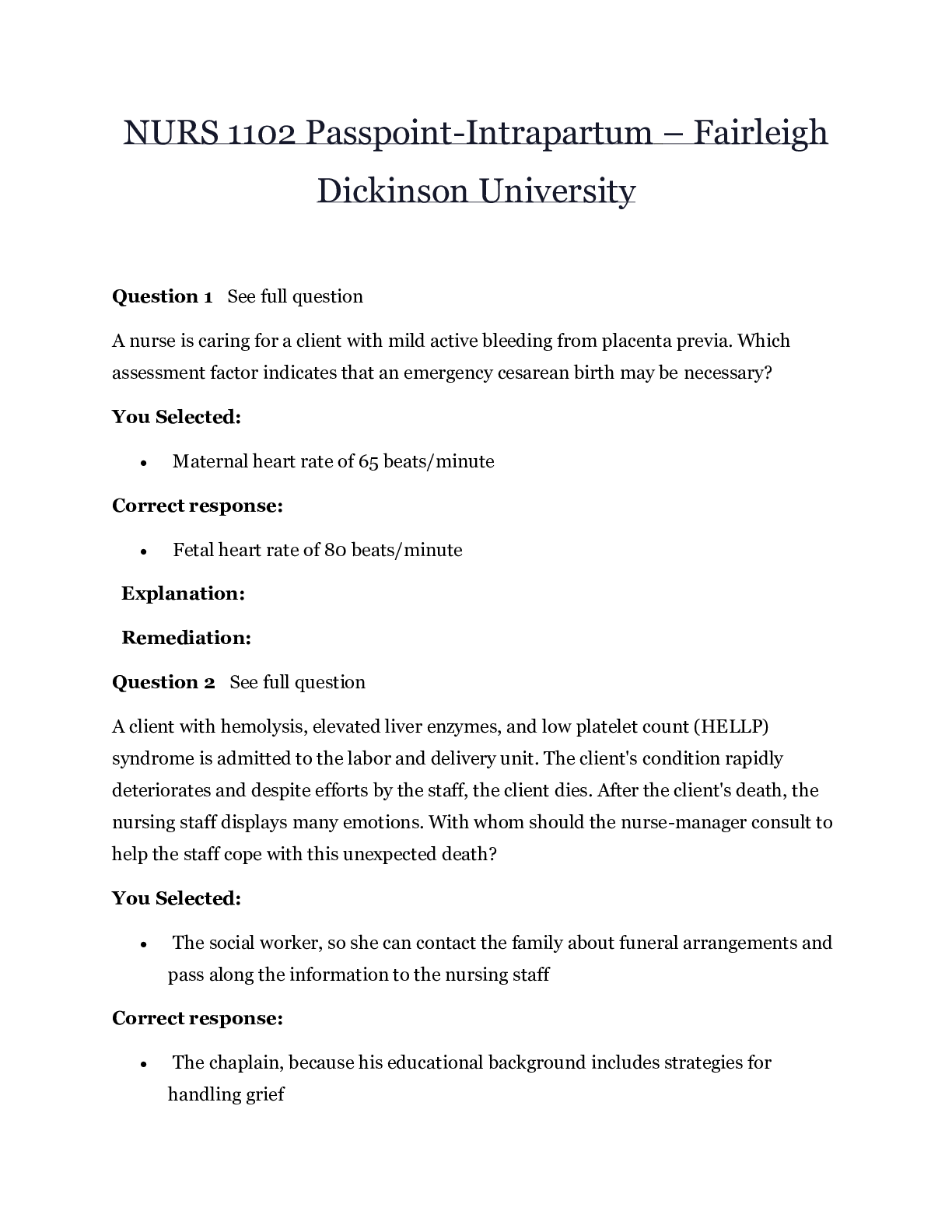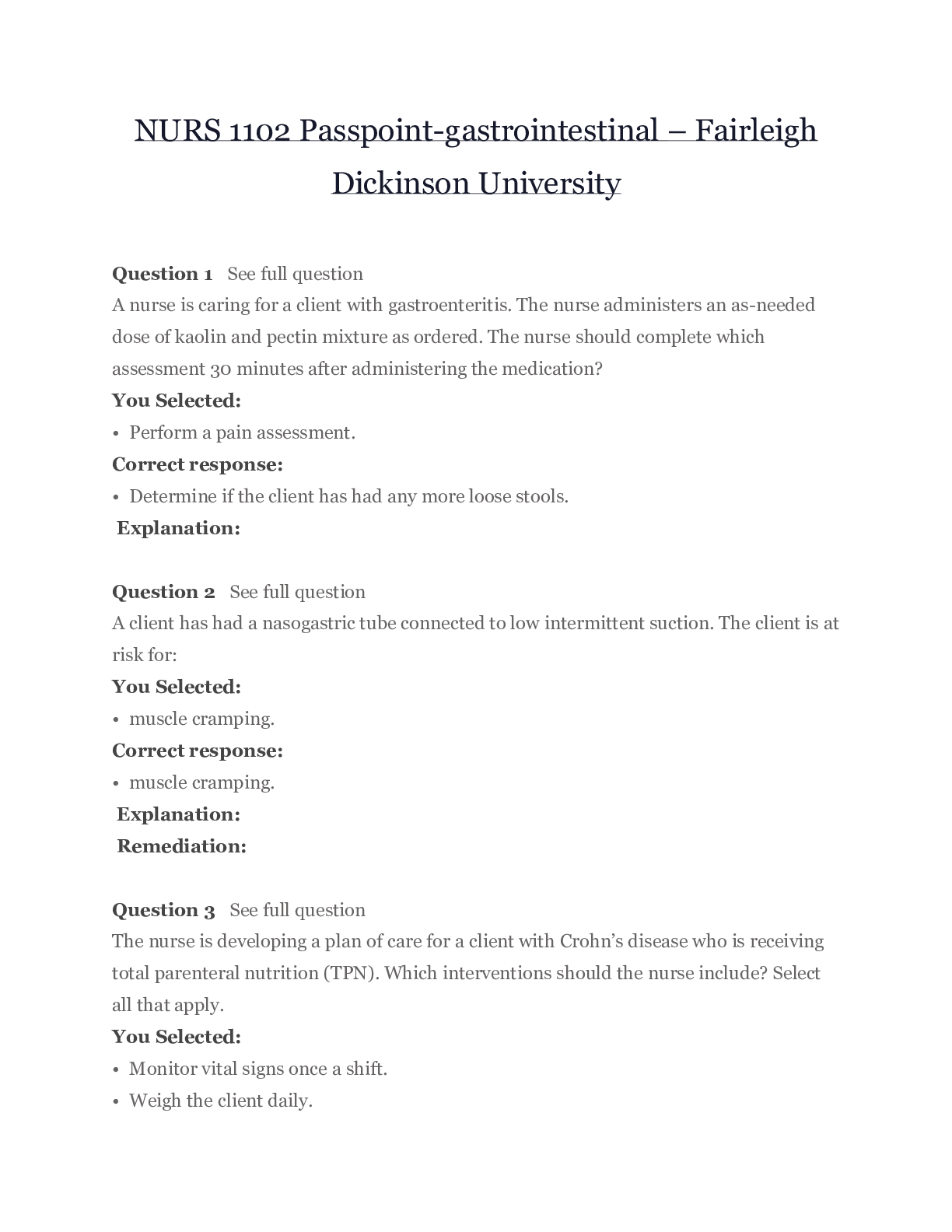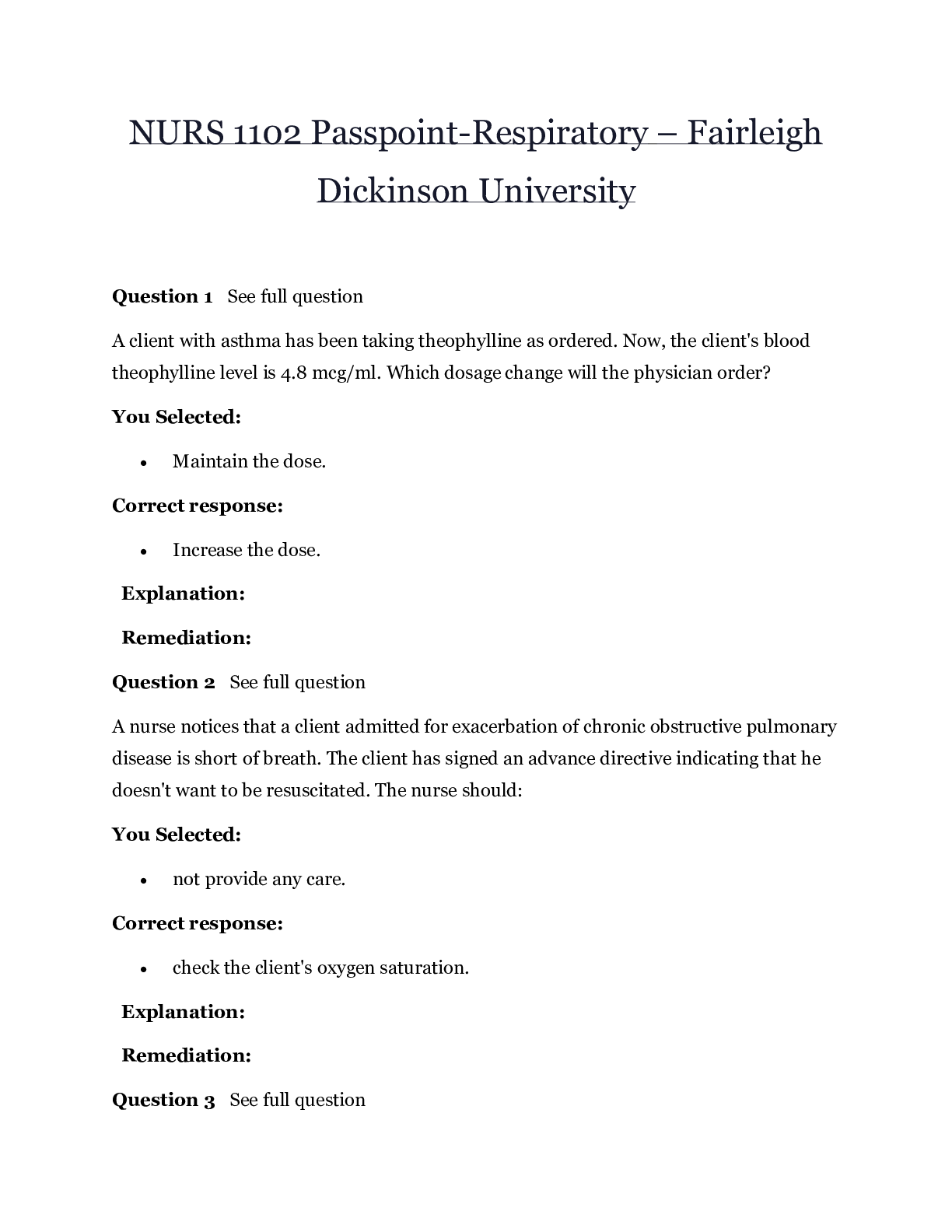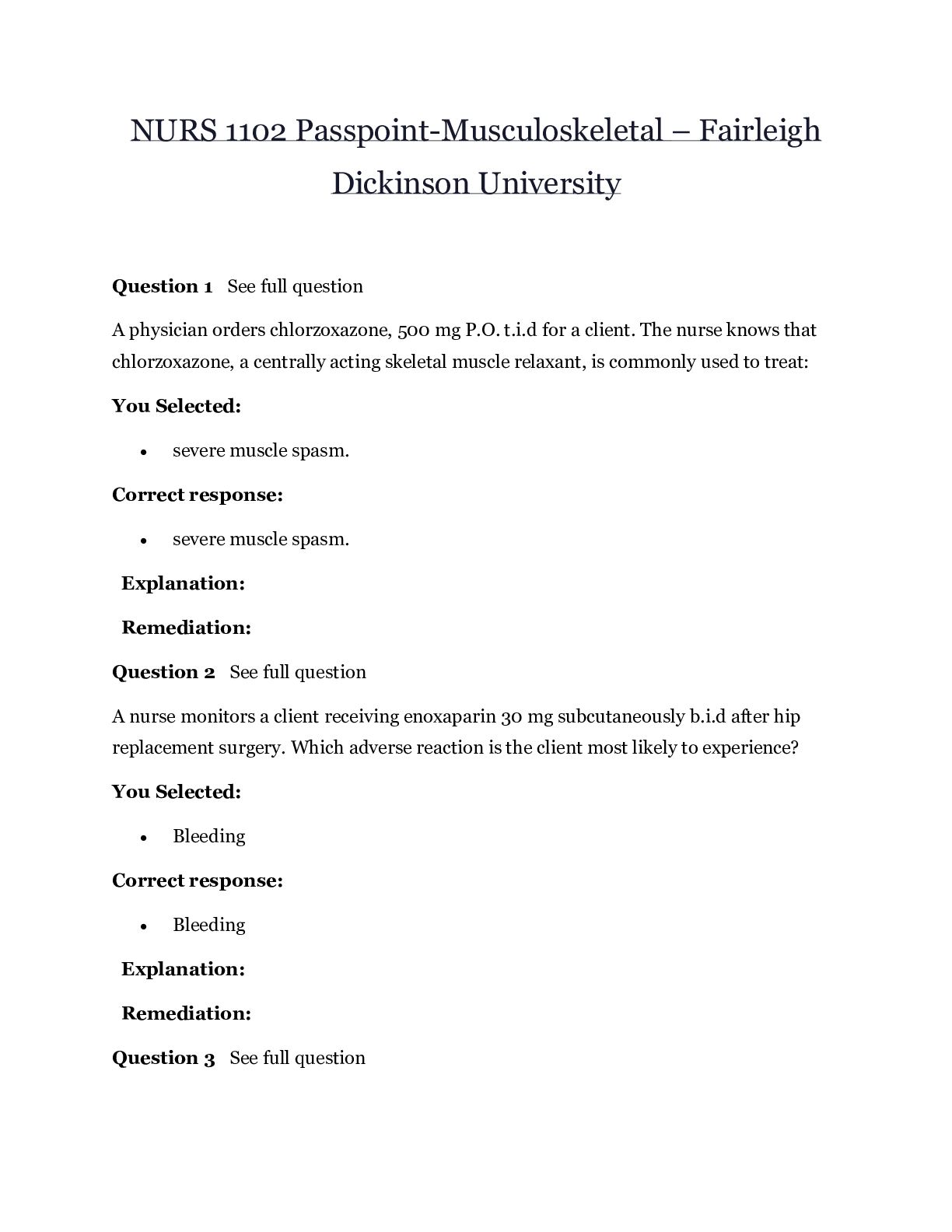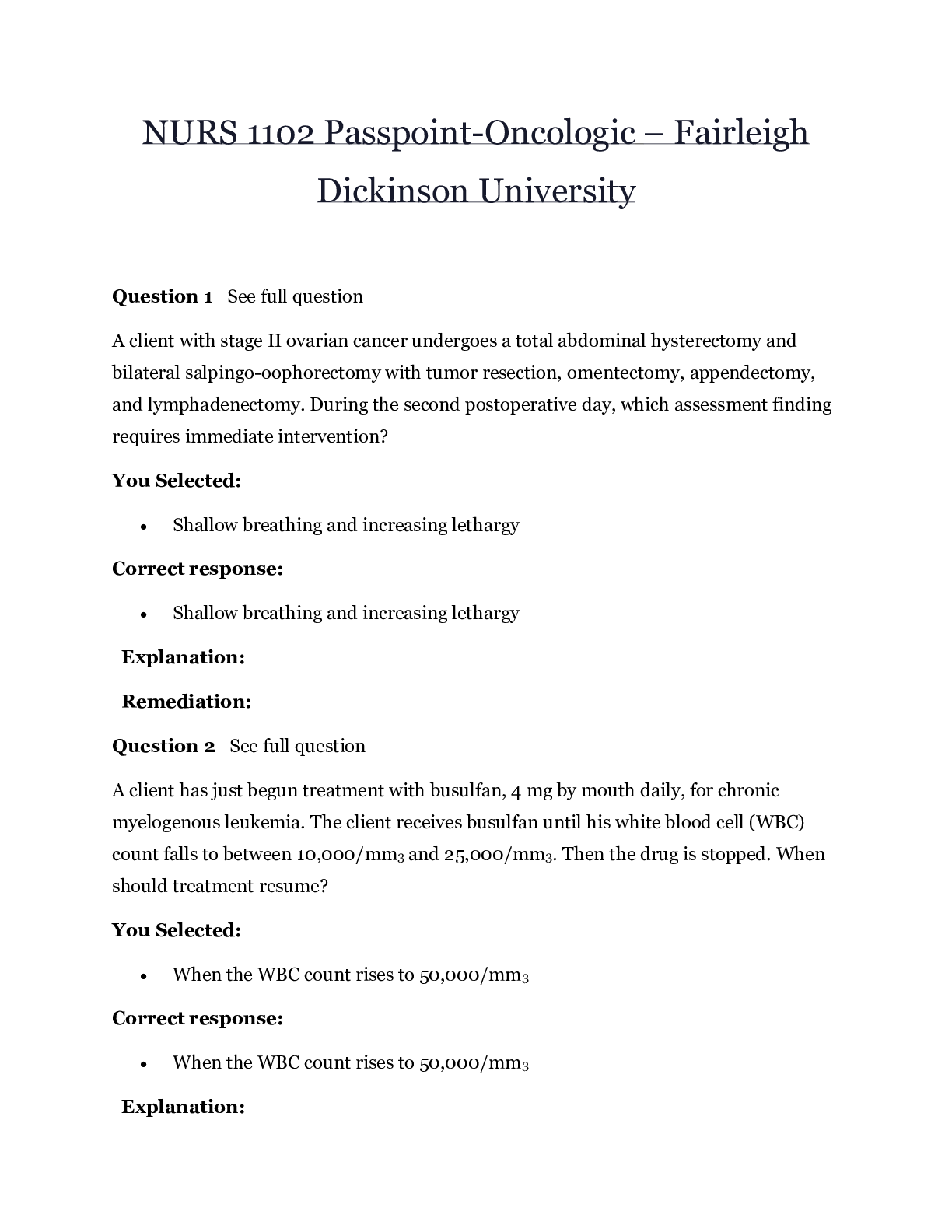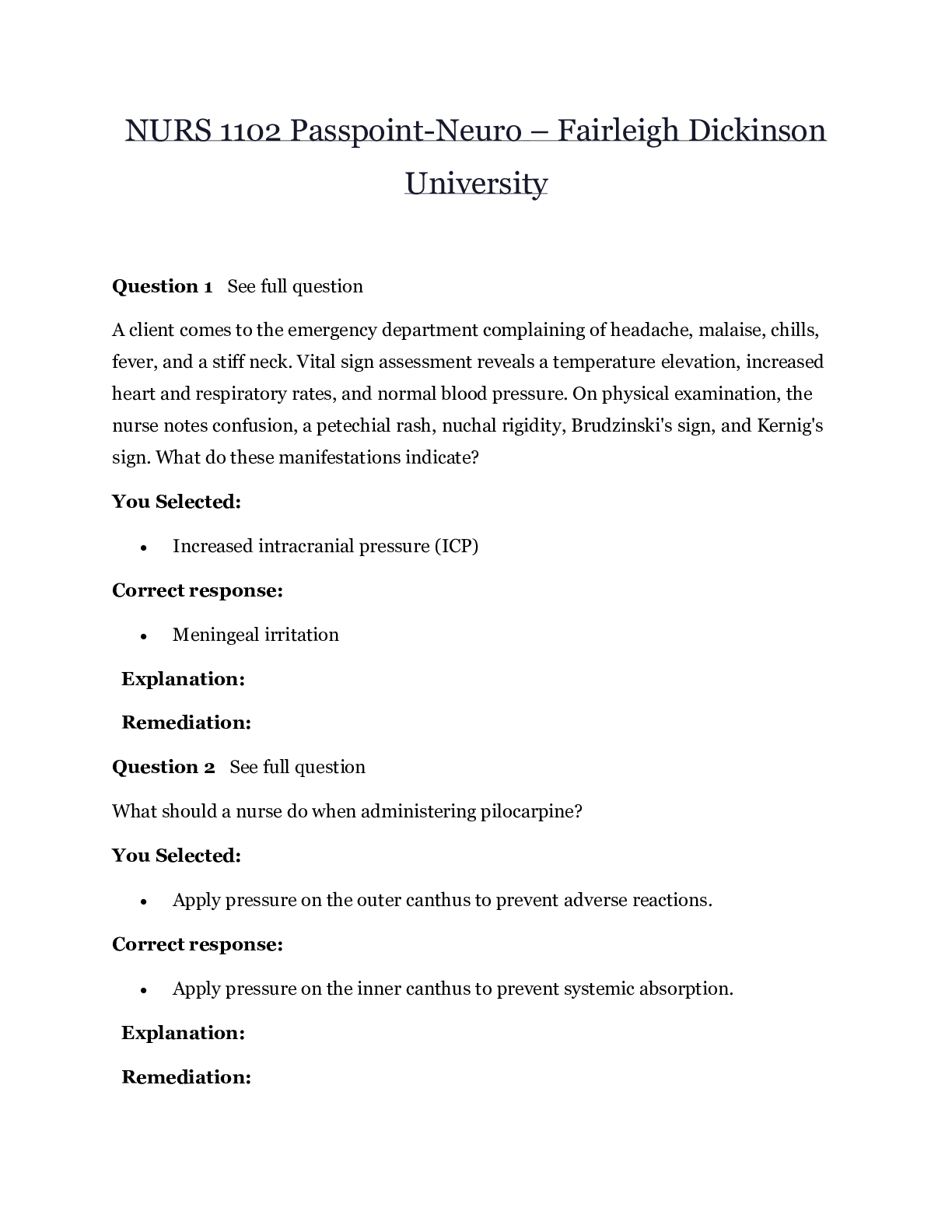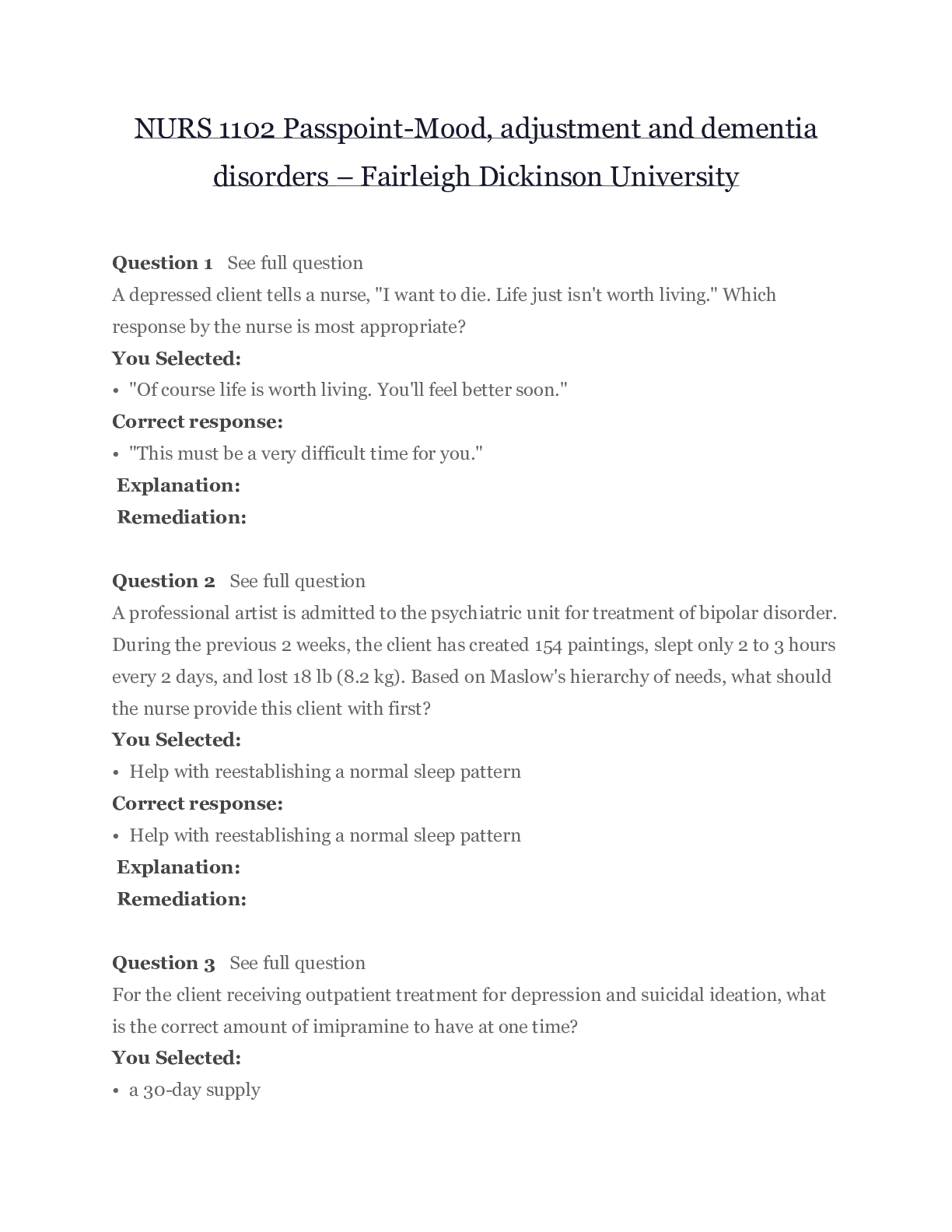*NURSING > EXAM > NURS 1102 Passpoint-cardiovascular – Fairleigh Dickinson University | NURS1102 Passpoint-cardiovas (All)
NURS 1102 Passpoint-cardiovascular – Fairleigh Dickinson University | NURS1102 Passpoint-cardiovascular
Document Content and Description Below
NURS 1102 Passpoint-cardiovascular – Fairleigh Dickinson University Question 1 See full question Which statement would lead the nurse to determine that a client lacks understanding of her ... acute cardiac illness and the ability to make changes in her lifestyle? You Selected: • "I talked with my husband yesterday about working on a new budget together." Correct response: • "I already have my airline ticket, so I will not miss my meeting tomorrow." Explanation: Question 2 See full question What is the expected outcome of thrombolytic drug therapy for stroke? You Selected: • dissolved emboli Correct response: • dissolved emboli Explanation: Remediation: Question 3 See full question The client with peripheral vascular disease has been prescribed diltiazem. The nurse should determine the effectiveness of this medication by assessing the client for: You Selected: • vasodilation. Correct response: • vasodilation. Explanation: Remediation: Question 4 See full question Alteplase recombinant, or tissue plasminogen activator (t-PA), a thrombolytic enzyme, is administered during the first 6 hours after onset of myocardial infarction (MI) to: You Selected: • reduce coronary artery vasospasm. Correct response: • revascularize the blocked coronary artery. Explanation: Remediation: Question 5 See full question A nurse is caring for a client with first-degree atrioventricular (AV) block. When instructing the spouse using a diagram, identify the area in the conduction cycle where this block occurs. You Selected: • Your selection and the correct area, market by the green box. Explanation: Question 6 See full question A postoperative client is receiving heparin after developing thrombophlebitis. The nurse monitors the client carefully for bleeding and other adverse effects of heparin. If the client starts to exhibit signs of excessive bleeding, the nurse should expect to administer an antidote that is specific to heparin. Which agent fits this description? You Selected: • Protamine sulfate Correct response: • Protamine sulfate Explanation: Remediation: Question 7 See full question Following a percutaneous transluminal coronary angioplasty, a client is monitored in the postprocedure unit. The client's heparin infusion was stopped 2 hours earlier. There is no evidence of bleeding or hematoma at the insertion site, and the pressure device is removed. The nurse should plan to safely remove the femoral sheath when the partial thromboplastin time (PTT) is: You Selected: • 75 seconds or less. Correct response: • 50 seconds or less. Explanation: Question 8 See full question Prior to administering tissue plasminogen activator (t-PA), the nurse should assess the client for which contradiction to administering the drug? You Selected: • history of heart failure Correct response: • history of cerebral hemorrhage Explanation: Remediation: Question 9 See full question The nurse is concerned about the risks of hypoxemia and metabolic acidosis in a client who is in shock. What finding should the analyze for evidence of hypoxemia and metabolic acidosis in a client with shock? You Selected: • Arterial blood gas (ABG) findings Correct response: • Arterial blood gas (ABG) findings Explanation: Remediation: Question 10 See full question Which assessment findings would the nurse expect to find in the postoperative client experiencing fat embolism syndrome? You Selected: • Column C Correct response: • Column B Question 1 See full question A nurse is preparing to administer cardiac medications to two clients with the same last name. She checks the medication three times before entering the room to administer medications to the first client. While leaving the room, the nurse realizes she didn't check the client's identification before administering the medication. Which action should the nurse take first? You Selected: • Document the medication error and completion of the variance report in the client's chart and notify the physician. Correct response: • Return to the room, check the client's identification against the medication administration record, and complete a variance report if needed. Explanation: Remediation: Question 2 See full question The nurse is assessing a client with irreversible shock. The nurse should document which finding? You Selected: • hypertension Correct response: • circulatory collapse Explanation: Remediation: Question 3 See full question The nurse instructs a client with coronary artery disease in the proper use of nitroglycerin. The client has had 2 previous episodes of coronary artery disease. At the onset of chest pain, what should the client do? You Selected: • Call 911 when three nitroglycerin tablets taken every 5 minutes are not effective. Correct response: • Call 911 when three nitroglycerin tablets taken every 5 minutes are not effective. Explanation: Remediation: Question 4 See full question A client with chest pain doesn't respond to nitroglycerin. When he's admitted to the emergency department, the health care team obtains an electrocardiogram and administers I.V. morphine. The physician also considers administering alteplase. This thrombolytic agent must be administered how soon after onset of myocardial infarction (MI) symptoms? You Selected: • Within 24 to 48 hours Correct response: • Within 6 hours Explanation: Remediation: Question 5 See full question A physician treating a client in the cardiac care unit for atrial arrhythmia orders metoprolol, 25 mg P.O. two times per day. Metoprolol inhibits the action of sympathomimetics at beta1-receptor sites. Where are these sites mainly located? You Selected: • Heart Correct response: • Heart Explanation: Remediation: Question 6 See full question A client with left-sided heart failure complains of increasing shortness of breath and is agitated and coughing up pink-tinged, foamy sputum. The nurse should recognize these findings as signs and symptoms of: You Selected: • right-sided heart failure. Correct response: • acute pulmonary edema. Explanation: Remediation: Question 7 See full question An 80-year-old client is admitted with nausea and vomiting. The client has a history of heart failure and is being treated with digoxin. The client has been nauseated for a week and began vomiting 2 days ago. Laboratory values indicate hypokalemia. Because of these clinical findings, the nurse should assess the client carefully for: You Selected: • digoxin toxicity. Correct response: • digoxin toxicity. Explanation: Remediation: Question 8 See full question The nurse is assisting a client with a stroke who has homonymous hemianopia. The nurse should understand that the client will: You Selected: • forget the names of foods. Correct response: • eat food on only half of the plate. Explanation: Remediation: Question 9 See full question A client prescribed propranolol calls the clinic to report a weight gain of 3 lbs (1.36 kg) within 2 days, shortness of breath, and swollen ankles. What is the nurse’s best action? You Selected: • Have the client come to the clinic in order to assess the lungs. Correct response: • Have the client come to the clinic in order to assess the lungs. Explanation: Remediation: Question 10 See full question The nurse is preparing to administer oral digoxin to a child and notes that the child has nausea, has vomited, and has a pulse rate of 45 beats per minute. Which of the following is the appropriate nursing action? You Selected: • Hold the digoxin and notify the physician of possible toxicity Correct response: • Hold the digoxin and notify the physician of possible toxicity Question 1 See full question What is a priority nursing assessment in the first 24 hours after admission of the client with a thrombotic stroke? You Selected: • echocardiogram Correct response: • pupil size and pupillary response Explanation: Remediation: Question 2 See full question When monitoring a client who is receiving tissue plasminogen activator (t-PA), the nurse should have resuscitation equipment available because reperfusion of the cardiac tissue can result in: You Selected: • hypertension. Correct response: • cardiac arrhythmias. Explanation: Remediation: Question 3 See full question In a client with chronic bronchitis, which sign would lead the nurse to suspect right-sided heart failure? You Selected: • Leg edema Correct response: • Leg edema Explanation: Remediation: Question 4 See full question Which indicates hypovolemic shock in a client who has had a 15% blood loss? You Selected: • systolic blood pressure less than 90 mm Hg Correct response: • systolic blood pressure less than 90 mm Hg Explanation: Remediation: Question 5 See full question Which symptom should the nurse teach the client with unstable angina to report immediately to the health care provider (HCP)? You Selected: • a change in the pattern of the chest pain Correct response: • a change in the pattern of the chest pain Explanation: Remediation: Question 6 See full question The nurse is admitting an older adult to the hospital. The echocardiogram report revealed left ventricular enlargement. The nurse notes 2+ pitting edema in the ankles when getting the client into bed. Based on this finding, what should the nurse do first? You Selected: • Assess respiratory status. Correct response: • Assess respiratory status. Explanation: Remediation: Question 7 See full question The nurse teaches a client who has recently been diagnosed with hypertension about following a low-calorie, low-fat, low-sodium diet. Which menu selection would best meet the client's needs? You Selected: • baked chicken, an apple, and a slice of white bread Correct response: • baked chicken, an apple, and a slice of white bread Explanation: Remediation: Question 8 See full question A client has been diagnosed with Raynaud’s phenomenon on the tip of the nose and fingertips. The healthcare provider (HCP) has prescribed reserpine to determine if the client will obtain relief. The client often works outside in cold weather and also smokes two packs of cigarettes per day. Which directions should be included in the discharge plan for this client? Select all that apply. You Selected: • Report signs of orthostatic hypotension. • Stop smoking. • Find employment that can be done in a warm environment. Correct response: • Stop smoking. • Wear a face covering and gloves in the winter. • Report signs of orthostatic hypotension. Explanation: Remediation: Question 9 See full question A client hospitalized with a myocardial infarction (MI) has a blood glucose levels ranging from 12-28 mmol/L (216-504 mg/dL) asks the nurse why the readings are so high even though there are no added sweets on the diet tray. What is the best response by the nurse? You Selected: • “The stress level in your body has increased with the MI, and more glucose is released during stressful times.” Correct response: • “The stress level in your body has increased with the MI, and more glucose is released during stressful times.” Explanation: Remediation: Question 10 See full question A client with chest pain, dyspnea, and an irregular heartbeat comes to the emergency department. An electrocardiogram shows a heart rate of 110 beats/minute (sinus tachycardia) with frequent premature ventricular contractions. Shortly after admission, the client has ventricular tachycardia and becomes unresponsive. After successful resuscitation, the client is taken to the intensive care unit (ICU). Which nursing diagnosis is the priority at this time? You Selected: • Ineffective tissue perfusion (cardiopulmonary) related to arrhythmia Correct response: • Ineffective tissue perfusion (cardiopulmonary) related to arrhythmia Question 1 See full question A client signed a consent form for participation in a clinical trial for implantable cardioverter-defibrillators. Which statement by the client indicates the need for further teaching before true informed consent can be obtained? You Selected: • "I wonder if there is any other way to prevent these bad rhythms." Correct response: • "I wonder if there is any other way to prevent these bad rhythms." Explanation: Remediation: Question 2 See full question The client asks the nurse, “Why will the health care provider not tell me exactly how much of my leg he is going to take off? Do you not think I should know that?” On which information should the nurse base the response? You Selected: • the adequacy of the blood supply to the tissues Correct response: • the adequacy of the blood supply to the tissues Explanation: Remediation: Question 3 See full question When assessing a client with left-sided heart failure, the nurse expects to note: You Selected: • pitting edema of the legs. Correct response: • air hunger. Explanation: Remediation: Question 4 See full question A nurse is providing discharge instructions to a client with peripheral vascular disease that include stress-reduction techniques. The client asks the nurse, "Why is reducing stress so important?" What is the nurse's best response? You Selected: • "Stress reduction techniques are helpful because stress stimulates the release of vasoconstricting catecholamines." Correct response: • "Stress reduction techniques are helpful because stress stimulates the release of vasoconstricting catecholamines." Explanation: Question 5 See full question A client who underwent total hip replacement exhibits a red, painful area on the calf of the affected leg. What test validates presence of thromboembolism? You Selected: • Homans' Correct response: • Homans' Explanation: Remediation: Question 6 See full question A client, hospitalized with heart failure, is receiving digoxin and furosemide intravenously and now has continuous ringing in the ears. What is the appropriate action for the nurse to take at this time? You Selected: • Obtain a digoxin level to check for toxicity. Correct response: • Discontinue the furosemide and notify the health care provider (HCP). Explanation: Remediation: Question 7 See full question An older adult with a history of heart failure is admitted to the emergency department with pulmonary edema. On admission, what should the nurse assess first? You Selected: • serum potassium level Correct response: • blood pressure Explanation: Remediation: Question 8 See full question One goal in caring for a client with arterial occlusive disease is to promote vasodilation in the affected extremity. To achieve this goal, the nurse should encourage the client to: You Selected: • stop smoking. Correct response: • stop smoking. Explanation: Remediation: Question 9 See full question When performing external chest compressions on an adult during cardiopulmonary resuscitation (CPR), the rescuer should depress the sternum: You Selected: • 1.5 inches (4 cm) Correct response: • 2 inches (5 cm) Explanation: Remediation: Question 10 See full question A nurse places electrodes on a collapsed individual who was visiting a hospitalized family member, the monitor exhibits the following. Which interventions would the nurse do first? You Selected: • Assess the client’s airway, breathing, and circulation. Correct response: • Assess the client’s airway, breathing, and circulation. Question 1 See full question A client with peripheral vascular disease has undergone a right femoral-popliteal bypass graft. The blood pressure has decreased from 124/80 mm Hg to 88/62 mm Hg. What should the nurse assess first? You Selected: • pedal pulses Correct response: • pedal pulses Explanation: Remediation: Question 2 See full question A client who has been experiencing angina has a new prescription for nitroglycerin. The nurse should instruct the client to report having which potential side effect of nitroglycerin? You Selected: • hypertension Correct response: • headache Explanation: Remediation: Question 3 See full question A client is receiving nitroglycerin ointment to treat angina pectoris. The nurse evaluates the therapeutic effectiveness of this drug by assessing the client's response and checking for adverse effects. Which vital sign is most likely to reflect an adverse effect of nitroglycerin? You Selected: • Pulse rate of 84 beats/minute Correct response: • Blood pressure 84/52 mm Hg Explanation: Remediation: Question 4 See full question A nurse is caring for a client with heart failure. The nurse knows that the client has left-sided heart failure when he makes which statement? You Selected: • "My feet are bigger than normal." Correct response: • "I sleep on three pillows each night." Explanation: Remediation: Question 5 See full question Metoprolol is added to the pharmacologic therapy of a woman with diabetes diagnosed with stage 2 hypertension and initially treated with furosemide and ramipril. An expected therapeutic effect is: You Selected: • decrease in heart rate. Correct response: • decrease in heart rate. Explanation: Remediation: Question 6 See full question A nurse is caring for a client with frequent episodes of ventricular tachycardia. The lab calls with a critically high magnesium level of 11 mg/dL on this client. What is the nurse's priority action? You Selected: • Obtain an order for calcium gluconate 2 g IV push over 2-5 minutes. Correct response: • Obtain an order for calcium gluconate 2 g IV push over 2-5 minutes. Explanation: Remediation: Question 7 See full question A client requested a do-not-resuscitate (DNR) order upon admission to the hospital. He now tells the nurse that he wants the medical team to do everything possible to help him get better and is concerned about the DNR order. Which response by the nurse is best? You Selected: • "It isn't a problem to rescind your DNR order; I'll let your physician know your wishes right away." Correct response: • "It isn't a problem to rescind your DNR order; I'll let your physician know your wishes right away." Explanation: Remediation: - - - - - - - - - - - - - - - - - - - - - - - - - Question 6 See full question After evaluating a client for hypertension, a physician orders atenolol, 50 mg P.O. daily. Which therapeutic effect should atenolol have? You Selected: • Decreased cardiac output and decreased systolic and diastolic blood pressure Correct response: • Decreased cardiac output and decreased systolic and diastolic blood pressure Explanation: Remediation: Question 7 See full question What mechanical device increases coronary perfusion and cardiac output and decreases myocardial workload and oxygen consumption in a client with cardiogenic shock? You Selected: • Intra-aortic balloon pump Correct response: • Intra-aortic balloon pump Explanation: Remediation: Question 8 See full question The nurse is developing a teaching plan for a client who will be starting a prescription for simvastatin 40 mg/day. What instructions should the nurse give the client? Select all that apply. You Selected: • "Report muscle pain or tenderness to your health care provider." • "Continue to follow a diet that is low in saturated fats." • "If you miss a dose, take it when you remember it." Correct response: • "If you miss a dose, take it when you remember it." • "Report muscle pain or tenderness to your health care provider." • "Continue to follow a diet that is low in saturated fats." Explanation: Remediation: Question 9 See full question A client reports recent onset of chest pain that occurs sporadically with exertion. The client also has fatigue and mild ankle swelling, which is most pronounced at the end of the day. The nurse suspects a cardiovascular disorder. What other client presentation increases the likelihood of a cardiovascular disorder? You Selected: • Clubbing of fingers Correct response: • Clubbing of fingers Explanation: Remediation: Question 10 See full question A client with atrial fibrillation has been receiving warfarin. The INR is 4.5. What is the next action the nurse should take? You Selected: • Withhold the next scheduled dose Correct response: • Withhold the next scheduled dose Question 1 See full question The client with peripheral artery disease reports both legs hurt when walking. What should the nurse instruct the client to do? You Selected: • Rest frequently with the legs elevated. Correct response: • Enroll in a supervised exercise training program. Explanation: Question 2 See full question A client has chest pain rated at 8 on a 10-point visual analog scale. The 12-lead electrocardiogram reveals ST elevation in the inferior leads and troponin levels are elevated. What should the nurse do first? You Selected: • Reduce pain and myocardial oxygen demand. Correct response: • Reduce pain and myocardial oxygen demand. Explanation: Remediation: Question 3 See full question A client who suffered blunt chest trauma in a motor vehicle accident complains of chest pain, which is exacerbated by deep inspiration. On auscultation, the nurse detects a pericardial friction rub — a classic sign of acute pericarditis. The physician confirms acute pericarditis and begins appropriate medical intervention. To relieve chest pain associated with pericarditis, which position should the nurse encourage the client to assume? You Selected: • Leaning forward while sitting Correct response: • Leaning forward while sitting Explanation: Remediation: Question 4 See full question A nurse is caring for a client with acute pulmonary edema. To immediately promote oxygenation and relieve dyspnea, the nurse should: You Selected: • place the client in high Fowler's position. Correct response: • place the client in high Fowler's position. Explanation: Remediation: Question 5 See full question A client is taking spironolactone. Which change in the diet should the nurse teach the client to make when taking this drug? You Selected: • Avoid eating foods high in potassium. Correct response: • Avoid eating foods high in potassium. Explanation: Remediation: Question 6 See full question A client with hypertensive emergency is being treated with sodium nitroprusside. In a dilution of 50 mg/250 mL, how many micrograms of nitroprusside are in each milliliter? Record your answer using a whole number. Your Response: • 200 Correct response: • 200 Explanation: Question 7 See full question A group has asked the nurse to discuss how lifestyle factors affect heart health. Which of the following statements by members of the group would indicate that the teaching was effective? Select all that apply. You Selected: • “Gradually increasing my exercise levels will help enhance circulation through the heart.” • “Walking is excellent exercise to strengthen my heart.” • “As a borderline diabetic, if I lose weight and lessen my intake of simple carbohydrates, this should benefit my heart.” • “If I change my diet and lessen my intake of saturated fats and trans fatty acids, this may decrease my cholesterol levels.” Correct response: • “Gradually increasing my exercise levels will help enhance circulation through the heart.” • “If I change my diet and lessen my intake of saturated fats and trans fatty acids, this may decrease my cholesterol levels.” • “As a borderline diabetic, if I lose weight and lessen my intake of simple carbohydrates, this should benefit my heart.” • “Walking is excellent exercise to strengthen my heart.” Explanation: Remediation: Question 8 See full question A client with aortic stenosis has increasing dyspnea and dizziness. Identify the area where the nurse would place the stethoscope to assess a murmur from aortic stenosis. You Selected: • Your selection and the correct area, market by the green box. Explanation: Remediation: Question 9 See full question A nurse notes that the client’s PR interval is .17 and the QRS complex is .10. What action should the nurse take next? You Selected: • Request a 12-lead electrocardiogram. Correct response: • Document the findings. Explanation: Remediation: Question 10 See full question The nurse is evaluating the therapeutic goal of a client with history of cardiac dysrhythmias and newly completed radiofrequency catheter ablation. Which client-centered goal is most appropriate? You Selected: • The client will have a regular heart rhythm from destruction of errant tissue of the heart. Correct response: • The client will have a regular heart rhythm from destruction of errant tissue of the heart. Question 1 See full question During digoxin therapy, a nurse should closely monitor a client's: You Selected: • serum potassium and creatine kinase (CK) levels. Correct response: • serum potassium and magnesium levels. Explanation: Remediation: Question 2 See full question The client has been prescribed lisinopril to treat hypertension. The nurse should assess the client for which electrolyte imbalance? You Selected: • hyperkalemia Correct response: • hyperkalemia Explanation: Remediation: Question 3 See full question The most effective measure the nurse can use to prevent wound infection when changing a client's dressing after coronary artery bypass surgery is to: You Selected: • observe careful handwashing procedures. Correct response: • observe careful handwashing procedures. Explanation: Remediation: Question 4 See full question A child with heart disease starts on oral digoxin. When preparing to administer the medication, what should the nurse do first? You Selected: • Check the last serum electrolyte results for the child. Correct response: • Check the last serum electrolyte results for the child. Explanation: Question 5 See full question A client is started on digoxin. The health care provider (HCP) prescribes IV push doses of 0.5 mg now, 0.25 mg in 8 hr., and another 0.25 mg in another 8 hr. The client has a 1,000 mL bag of normal saline infusing at 25 mL/hr. What action should the nurse perform? You Selected: • Infuse each dose over 30 minutes using an IV piggyback set-up. Correct response: • Administer each dose of medication over 5 minutes via IV push. Question 1 See full question A client has severe arterial occlusive disease and gangrene of the left great toe. Which finding is expected? You Selected: • loss of hair on the lower leg Correct response: • loss of hair on the lower leg Explanation: Remediation: Question 2 See full question A client is admitted for treatment of Prinzmetal's angina. When developing this client's care plan, the nurse should keep in mind that this type of angina can result from: You Selected: • activities that increase myocardial oxygen demand. Correct response: • coronary artery spasm. Explanation: Question 3 See full question Which is an expected outcome for a client on the second day of hospitalization after a myocardial infarction (MI)? The client: You Selected: • can identify risk factors for MI. Correct response: • can perform personal self-care activities without pain. Explanation: Remediation: Question 4 See full question A nurse assesses a client who is in cardiogenic shock. Which statement by the nurse best indicates an understanding of cardiogenic shock? You Selected: • “A decrease in cardiac output and evidence of inadequate circulating blood volume and movement of plasma into interstitial spaces” Correct response: • “A decrease of cardiac output and evidence of tissue hypoxia in the presence of adequate intravascular volume” Explanation: Remediation: Question 5 See full question A client newly diagnosed with deep vein thrombosis (DVT) of the left lower left extremity is on bed rest. The nurse should instruct the unlicensed assistive personnel (UAP) providing routine morning care for the client to: You Selected: • ensure that the lower extremity is elevated. Correct response: • ensure that the lower extremity is elevated. Question 1 See full question Which instructions should the nurse give to a client with peripheral arterial occlusive disease? Select all that apply. You Selected: • Warm the fingers or toes by using an electric heating pad. • Wear extra socks in the winter. • Limit walking to one block at a time. Correct response: • Avoid sunburn during the summer. • Wear extra socks in the winter. • Wear clean, loose, soft cotton socks. Explanation: Remediation: Question 2 See full question An obese white male client, age 49, is diagnosed with hypercholesterolemia. The physician orders a low-fat, low-cholesterol, low-calorie diet to reduce blood lipid levels and promote weight loss. This diet is crucial to the client's well-being because his race, sex, and age increase his risk for coronary artery disease (CAD). To determine whether the client has other major risk factors for CAD, the nurse should assess for: You Selected: • alcoholism. Correct response: • a history of diabetes mellitus. Explanation: Remediation: Question 3 See full question A client with angina pectoris must learn how to reduce risk factors that exacerbate this condition. When developing the client's care plan, which expected outcome should a nurse include? You Selected: • "Client will verbalize the intention to stop smoking." Correct response: • "Client will verbalize the intention to stop smoking." Explanation: Remediation: Question 4 See full question The primary goal for the client with Buerger's disease is to prevent: You Selected: • thrombus formation. Correct response: • thrombus formation. Explanation: Remediation: Question 5 See full question A client who has diabetes is taking metoprolol for hypertension. What should the nurse instruct the client to do? Select all that apply. You Selected: • Do not crush or chew the tablets. • Report any fainting spells to the health care provider (HCP). • Take the tablets with food at same time each day. Correct response: • Take the tablets with food at same time each day. • Do not crush or chew the tablets. • Have a blood glucose level drawn every 6 to 12 months during therapy. • Report any fainting spells to the health care provider (HCP). Explanation: Remediation: Question 6 See full question The nurse is caring for a client admitted for a quadruple coronary artery bypass graft. Which of the following statements by the client indicate that preoperative teaching has not been effective? Select all that apply. You Selected: • “I had stopped smoking a month before the surgery; however, I will be able to start again once I have recovered.” • “I will be relieved to have this surgery over with; I have a very busy schedule at work right now.” Correct response: • “I will be relieved to have this surgery over with; I have a very busy schedule at work right now.” • “I had stopped smoking a month before the surgery; however, I will be able to start again once I have recovered.” Explanation: Remediation: Question 7 See full question A client is diagnosed with thrombophlebitis. What nursing action would demonstrate the appropriate level of activity for this client? You Selected: • Bed rest with elevation of the affected extremity Correct response: • Bed rest with elevation of the affected extremity Explanation: Remediation: Question 8 See full question The nurse is completing the preoperative checklist for a client going to surgery. Which of the following client statements would be of the most concern to the nurse and require that the surgeon be notified immediately? You Selected: • “I am allergic to penicillin.” Correct response: • “I had a few sips of water with dabagatran this morning.” Explanation: Remediation: Question 9 See full question Which client has a need for prophylactic antibiotic therapy prior to dental manipulations? You Selected: • The client with an aortic valve replacement 5 years ago Correct response: • The client with an aortic valve replacement 5 years ago Explanation: Remediation: Question 10 See full question A nurse notes that the client’s PR interval is .17 and the QRS complex is .10. What action should the nurse take next? You Selected: • Document the findings. Correct response: • Document the findings. [Show More]
Last updated: 1 year ago
Preview 1 out of 181 pages
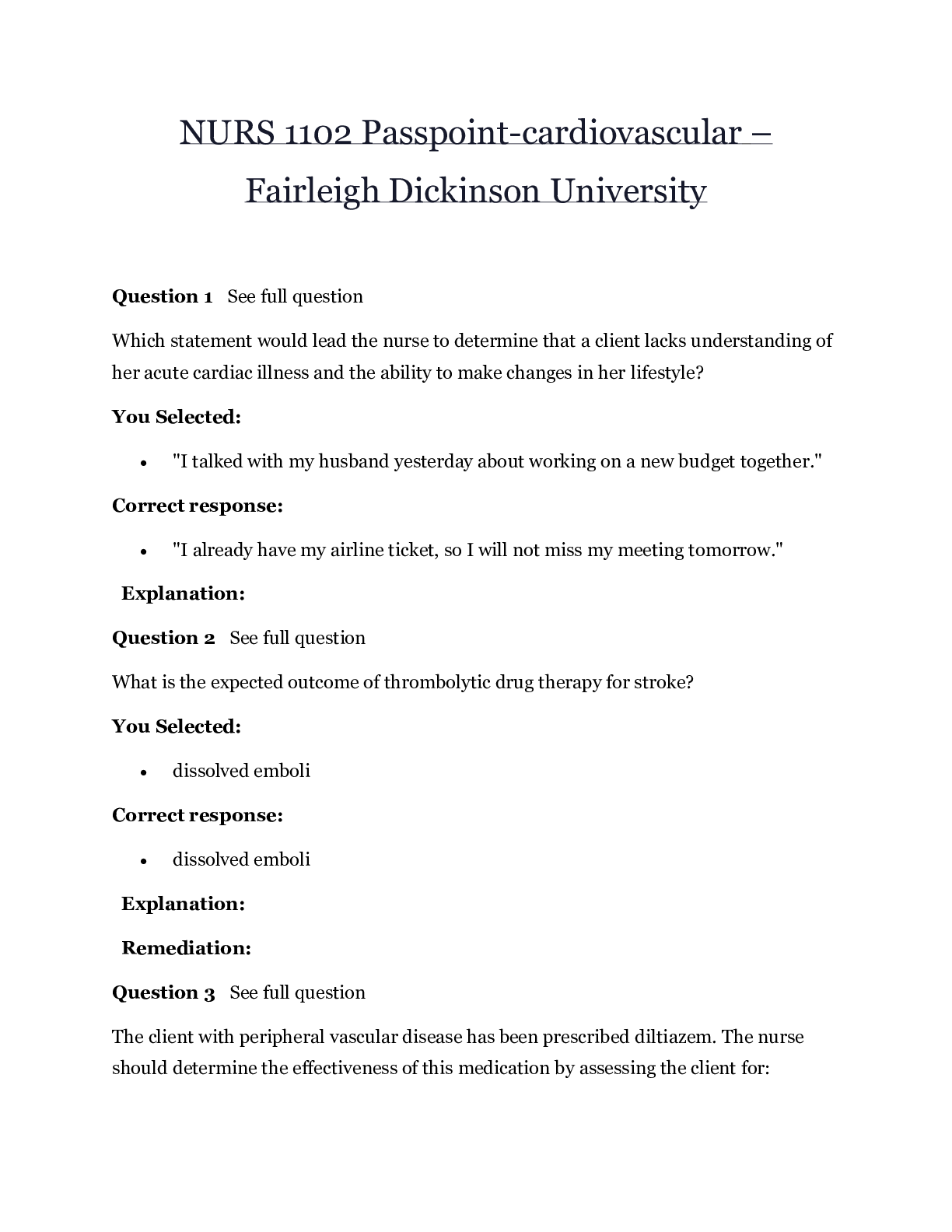
Buy this document to get the full access instantly
Instant Download Access after purchase
Add to cartInstant download
We Accept:

Reviews( 0 )
$16.50
Document information
Connected school, study & course
About the document
Uploaded On
Aug 15, 2020
Number of pages
181
Written in
Additional information
This document has been written for:
Uploaded
Aug 15, 2020
Downloads
0
Views
63














